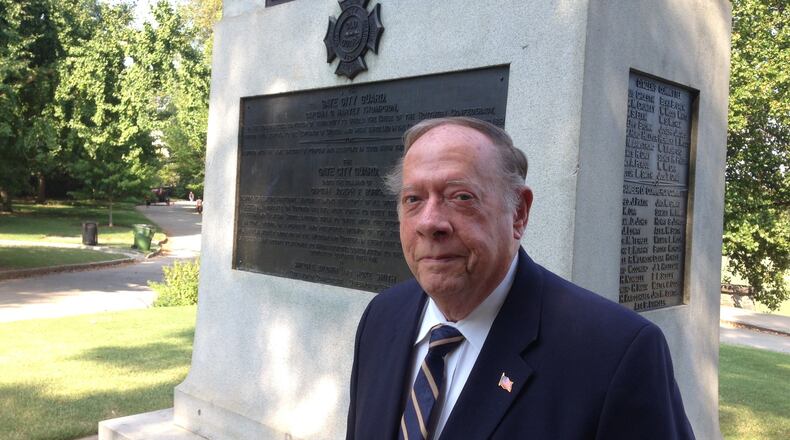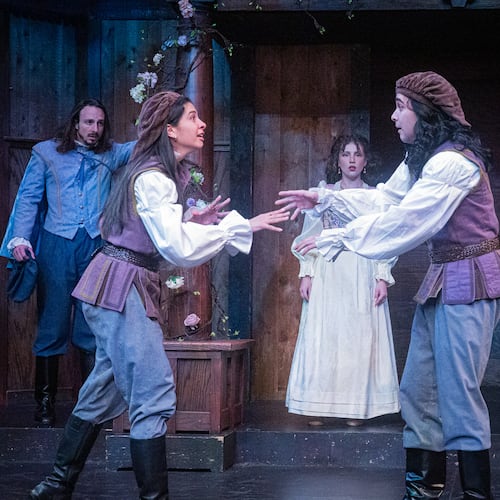My guess is that most people, especially those of African-American descent, will see the Peace Monument at the 14th Street entrance of Piedmont Park as just another Confederate symbol of hatred.
It won’t matter much that the Old Guard of the Gate City Guard erected the bronze statue in 1911 to mark the peaceful reunion of Northern and Southern states after the bitterly fought Civil War.
But that’s precisely the reason John Green believes it’s important people know the monument’s history and why the rest of us shouldn’t ignore its annual rededication.
“We’re a Confederate unit but we are a group that tries to continue the virtues of the old South,” he said.
Green, 81, of Stone Mountain, has been a member of the Old Guard of The Gate City Guard since 2006 when a friend extended an invitation to him to join.
He’s admittedly a bit sketchy on the details but according to Green, the Old Guard traces its history back to 1854 when a group of Atlanta residents formed a volunteer militia, which was not much more than a social club with uniforms.
When armed conflict broke out between the Confederate and Union states, the Gate City Guard was one of the first units to respond to Confederate President Davis’s request for troops. But by the end of the war, the South was defeated and the Gate City Guard disbanded.
When they felt that they were too old to serve on active duty, they resigned and reorganized under the Old Guard Battalion of the Gate City Guard.
It was the Old Guard, Green said, that realized they needed to do something to reunite the nation. They traveled to several northern cities on a peace mission.
“They were received very graciously by the Northern people,” Green said.
To commemorate their reconciliation efforts, the Old Guard decided to erect a peace monument in Piedmont Park, and on Oct. 11, 1911, more than 50,000 people, including Governors and Mayors, from many Northern and Southern States across the country gathered to dedicate the memorial.
Every year since then, members of the Old Guard have returned to rededicate the monument, which is why Green reached out to me.
At 2 p.m. Oct. 1, they will return once more to do the same.
“We’re proud of the fact we erected the Peace Monument and people need to know about it,” he said.
In terms of lives lost, the Civil War was America’s most costly war. On the Union side, 360,000 soldiers died (of wounds or disease), and on the Confederate side, another 260,000 men died. Combined, the fatalities surpassed the total for World War II.
Georgia sent 125,000 troops into the war, and 25,000 died on the battlefield, and when Atlanta fell in the summer of 1864, the Confederacy, for all practical purposes, fell with it.
I mentioned the dead because they, at least, deserve remembering.
But while it’s hard not to think of the Old Guard’s Peace Monument as glorifying the Confederacy, you have to wonder if it is indeed the “peace” monument Green sees or a “Lost Cause” monument.
Sheffield Hale, CEO of the Atlanta History Center, said a similar monument, erected in 1944 to “American Valor” by the Atlanta Historical Society, stands in front of Piedmont Hospital.
It and the Piedmont Park Peace Monument, he said, are different kinds of Civil War monuments that speak to national reconciliation but within the context of their era.
These are Atlanta-type monuments in that they are more progressive, he said. That doesn’t mean they are perfect. They purposely ignore that the end of slavery was the most significant outcome of the war.
But they are about reconciliation, “about the U.S. coming together again, and you don’t see that in a lot of Confederate monuments,” Hale said.
In fact, if Atlanta were going to do a monument on the war that fits into its ‘City Too Busy to Hate’ image, this would be it, he said. Still, reconciliation, the Lost Cause and white supremacy are not mutually exclusive.
He said, “In short, it’s complicated.”
Yes, indeed.
About the Author
Keep Reading
The Latest
Featured



